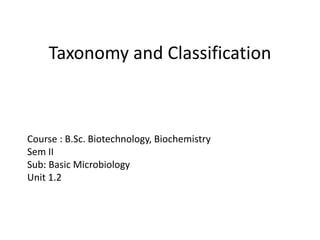
B.Sc. Biotech Biochem II BM Unit-1.2 Taxonomy and Classification
- 1. Taxonomy and Classification Course : B.Sc. Biotechnology, Biochemistry Sem II Sub: Basic Microbiology Unit 1.2
- 2. Taxonomy • Taxonomy = systematics • science of biological classification, provides a way to identify organisms and place them in groups with similar characteristics • Consists of 3 parts: 1. Classification 2. Identification 3. Nomenclature of (micro)organisms
- 3. • Phylogeny – evolutionary history of organism • Taxonomy produces a formal system for naming and classifying species to illustrate their evolutionary relationship.
- 4. To understand how the classification system works, let’s compare finding a species to mailing a letter from overseas. Classification Hierarchy Letter Hierarchy Kingdom Animalia Country United States Phylum/Division* Chordata State Pennsylvania Class Mammal City/Town DuBois Order Primate Street Orient Avenue Family Homoidae House Number 1 Genus Homo Last Name Horse Species sapiens First Name Charlie 4
- 5. Phylogenetic tree • Represents hypothesis based on lines of evidence (i.e. fossils, homologous form) • Family tree shows evolutionary relationships 5
- 6. 6
- 7. Types of Classification Systems First classification system developed by Aristotle. • Aristotle divided living organisms into: – Plants; • Herbs, • Bushes, • Trees. – Animals; • Land, • Water, • Air. 7
- 8. Types of Classification Systems cont. • Carlolus Linnaeus proposed the Two Kingdom Classification in 1758. • The two kingdoms consisted of: – Plantae – Animalia 8
- 9. THREE KINGDOM SYSTEM • ERNEST HAECKEL‐1866 • KINGDOM PROTISTA: – It includes unicellular & colonial eukaryotes such as bacteria, algae, fungi & protozoans. • KINGDOM PLANTAE: – It includes multicellular photosynthetic plants. • KINGDOM ANIMALIA: – It includes multicellular animals.
- 10. Types of Classification Systems cont. • The next classification system that came about consisted of 5 kingdoms. • It was proposed by Robert Whittaker in 1969. • The 5 kingdoms consisted of: – Plantae – Animalia – Fungi – Protista – Monera 10
- 11. Robert Whittaker’s Five Kingdom System • Plantae – Plants are immobile, multicellular eukaryotes that produce their food by photosynthesis and have cells encased in cellulose cell walls. – Examples: Ferns, pine trees, roses • Animailia – Animals are multicellular, heterotrophic eukaryotes that are capable of mobility at some stage during their lives, and that have cells lacking cell walls. – Examples: Humans, worms, spiders 11
- 12. Robert Whittaker’s Five Kingdom System • Fungi – Fungi are a eukaryotic, heterotrophic, usually multicellular group having multinucleated cells enclosed in cells with cell walls. – They obtain their energy by decomposing dead and dying organisms and absorbing their nutrients from those organisms. – Examples: Mushrooms, moulds, yeast 12 1
- 13. • Protista • The most ancient eukaryotic kingdom, protista include a variety of eukaryotic forms. • Perhaps they are best defined as eukaryotes that are not fungi, animals, or plants. • Cell wall is usually absent, if present it is impregnated with silica (diatoms). • Photosynthetic or non photosynthetic. • Locomotory structure may be cilia, flagella, pseudopodia or absent. • Examples: Paramecium, amoeba, diatom, euglena, some algae (unicellular), slime moulds Robert Whittaker’s Five Kingdom System
- 15. Robert Whittaker’s Five Kingdom System • Monera – Monera are the only kingdom composed of prokaryotic organisms, they have a cell wall, and lack both membrane-bound organelles and multicellular forms. – Examples: Bacteria, blue-green bacteria (cyanobacteria) 15
- 16. Characteristics of Monera • Unicellular or filamentous prokaryotes • Omni present (air, soil, hot springs, deserts, deep sea, snow & as parasites) • Cell wall is composed of polysaccharides & amino acids(peptido glycons ormurein) • Autotrophic (photo & chemosynthetic) & heterotrophic (saprophytic & parasitic) • Reproduce by vegetative, asexual & sexual methods 16
- 17. • MAJOR GROUPS OF MONERA: 1. Archaebacteria: Methanogens, Halophyles, thermoacidophyles 2. Eubacteria: Vibrio, mycobacteria 3. Cyanobacteria: Nostoc, Anabena 1 7 HalobacteriumVibrioAnabenaNostoc 6 7 8 9
- 18. Types of Classification Systems cont. • In the 1970’s, microbiologist Carl Woese, among other researchers conducted studies and concluded that a group of prokaryotic microorganisms called archaebacteria are separate from other monerans. • Therefore, they decided to split kingdom monera into two separate kingdoms: – Eubacteria – Archaebacteria 18
- 19. • Archaebacteria – Unicellular – Prokaryotic – Exist in extreme environments – they do not need oxygen or light to live – Examples: methanogens, extreme thermophiles, extreme halophiles • Eubacteria – Unicellular – Prokaryotic – Heterotrophic, autotrophic, and chemotrophic – Examples: Bacteria, cyanobacteria (blue-green bacteria) 19
- 20. Six Kingdom System • The six kingdom system consists of: – Eubacteria – Archaebacteria – Protista – Fungi – Plantae – Animalia • Come up with a mnemonic to remember these six kingdoms! – This mnemonic does not need to be in any particular order. 20
- 21. Binomial Nomenclature • What is it? – A two name system for writing scientific names 1. Genus name – written first and always capitalized 2. Species name – written second and never capitalized • Both words are to be italicized if typed, or underlined if hand written • Example: Felis concolor or F. concolor • The species name usually relates to some characteristic of the species or to the person who found the original. For example, the scientific name for humans is Homo sapiens. (Genus Homo=man, sapiens=thinking. Literally, in Latin, thinking man.) 21
- 22. Advantages to Binomial Nomenclature • Indicates similarities in anatomy, embryology, and evolutionary ancestry • Example: – The system suggests that the North American black bear (Ursus americanus) and the grizzly bear (Ursus horribilis) are closely related – Similar organisms are grouped into the same genus – in this case, Ursus 22
- 23. References Books: 1. Biology of microorganisms By M. T. Madigan, J. M. Martinko, D. A. Stahl and D. P. Clark Images: 1. https://lh4.ggpht.com/BL8zyuw37iAzWft6GzMuHTWQ7LmX1pGCKxaXjY_wF8R uMzVbHGnNAsu-XFO-r6w_ozc8hHM=s125 2. http://cfb.unh.edu/phycokey/Choices/Amoebae_Flagellates_Ciliates/Ciliates/P ARAMECIUM/Paramecium_05_600x395_caudatum.jpg 3. http://www.bodc.ac.uk/projects/uk/mfmb/introduction/images/diatoms.jpg 4. http://www.microscopy-uk.org.uk/mag/imgsep01/amoebaproteus450.jpg 5. https://lh6.ggpht.com/mkGhpDrT154r8rgB0tTM4wfgOG0- ULTlnUzmbRT7pvKbgVUoTrBC9XuJEqxTdQkEniP1jQ=s170 6. http://www.ohio.edu/plantbio/vislab/algaeimage/jpegs/nost1nitr.JPG 7. http://protist.i.hosei.ac.jp/PDB/images/Prokaryotes/Nostocaceae/Anabaena/A nabaena9c.jpg 8. https://s3.amazonaws.com/healthtap-public/ht- staging/user_answer/reference_image/8742/large/Cholera.jpeg?1344948822 9. http://plantphys.info/organismal/lechtml/images/halobacterium.jpg
